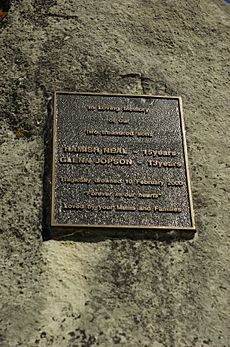Waihao River facts for kids
The Waihao River is a natural river in the Canterbury area of New Zealand's South Island. It flows into the Wainono Lagoon near a place called Studholme.
The New Zealand Ministry for Culture and Heritage says the name Waihao means "water of net fishing" or "water with eels". The word Hao specifically refers to the shortfin eel.
Contents
Where Does the Waihao River Start?
The Waihao River begins in the Hunter Hills. These hills are part of the Southern Alps. The area where all the river's water collects, called its catchment, is about 550 square kilometers (212 square miles). This area gets around 1,000 millimeters (39 inches) of rain every year.
Higher up, the river has two main parts: the North Branch and the South Branch. These two parts join together at a spot called Waihao Forks. The river usually flows in a clear path. But as it gets closer to the coast, it becomes a braided river. This means it splits into many smaller channels that weave in and out. It also spreads out into a flat area called a floodplain, which is about 25 square kilometers (10 square miles).
When the river reaches the coast, it turns and flows north. The Waimate Creek joins it before it empties into the Wainono Lagoon in Studholme. This place is east of the town of Waimate. There's also a special tunnel, called the Waihao Box. It was cut through the gravel bank that separates the river from the Pacific Ocean. This tunnel helps the river always have a way to reach the sea.
Bridges Over the Waihao River
Two main roads cross the Waihao River. State Highway 1 crosses it close to the coast. This is between the towns of Willowbridge and Morven. Further inland, State Highway 82 crosses the river at Waihao Forks.
Near the State Highway 1 crossing, the Main South Line railway also goes over the river. There used to be another railway line, the Waimate Gorge Branch, that crossed the river inland. However, this railway line closed in 1953, and its bridges have been taken away.
What is the Waihao River Used For?
People use the land along the Waihao River for farming. Because of this, the river is an important source of water for irrigation. This means farmers use the river water to help their crops grow.
The river is also a popular spot for fun activities. People who like to fish often visit the river to catch brown trout. There's also a walking path that follows the river for about 5 kilometers (3.1 miles) near Waihao Forks.
Flooding and How It's Managed
The Waihao River has often had big floods. In the 1900s, there were eighteen major floods. The only times without big floods were the 1910s and 1970s. From 1950 to 1953, there was a major flood every single year!
To help stop flooding, Environment Canterbury and the local council have put plans in place. They work to keep the stopbanks strong. Stopbanks are like walls that help hold the river in its path. They also manage the land along the riverbanks, called the riparian zone, to stop the soil from washing away. Plus, they limit new buildings in certain areas to reduce damage if a flood does happen.


